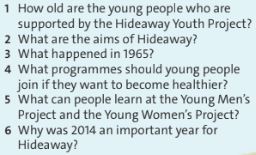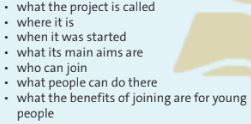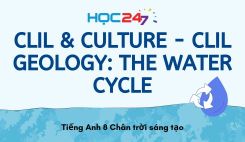Thông qua bài học này, các em có thể nghiên cứu và nói về các dự án của giới trẻ qua chủ đề “Youth projects”. HOC247 xin gửi đến các em bài học và cách giải chi tiết phần CLIL & Culture - Culture Chương trình Tiếng Anh lớp 8 Chân trời sáng tạo. Chúc các em học vui và có kết quả tốt!
Tóm tắt bài
1.1. CLIL & Culture lớp 8 Culture Task 1
Read the article about the Hideaway Youth project. Why did the project win an award?
(Đọc bài viết về dự án Hideaway Youth. Tại sao dự án giành được giải thưởng?)
|
HIDEAWAY YOUTH PROJECT Helping young people to make a difference Aims Hideaway tries to support young people aged eleven to twenty-five in Moss Side, Manchester. The organisation aims to give young people a way of expressing their opinions and making positive contributions to society. History In the 1960s, the city of Manchester had problems with crime, violence and unemployment. The founders of the Hideaway Youth Project wanted to provide a safe place – a ‘hideaway’ for young people in the Moss Side area in particular. Since opening in 1965, the project has helped thousands of teenagers of different cultures, religions and races. They can share their stories and get advice, as well as take part in activities that develop skills. Many of these teenagers then go on to become project volunteers themselves. Activities Programmes include: Powerhouse – fun sports activities such as football and basketball, or specialist sessions on cooking and art. Healthy Living – young people learn about how important it is to eat well and do regular exercise. Young Men’s Project and Young Women’s Project – these two separate projects support and encourage young men and women to talk about sensitive topics openly and honestly. The sessions promote acceptance and tolerance, and build self-confidence. Award winners In 2014, the Hideaway Youth Project won the Youth Work Award for their success in helping young people be the best that they can be. |
Tạm dịch:
|
DỰ ÁN THANH NIÊN HIDEAWAY Giúp người trẻ tạo nên sự khác biệt Mục tiêu Hideaway cố gắng hỗ trợ những người trẻ từ 11 đến 25 tuổi ở Moss Side, Manchester. Tổ chức nhằm mục đích cung cấp cho những người trẻ tuổi một cách bày tỏ ý kiến của họ và đóng góp tích cực cho xã hội. Lịch sử Vào những năm 1960, thành phố Manchester gặp vấn đề về tội phạm, bạo lực và thất nghiệp. Những người sáng lập Dự án Hideaway Youth muốn cung cấp một nơi an toàn - một 'nơi ẩn náu' cho những người trẻ tuổi ở khu vực Moss Side nói riêng. Kể từ khi mở cửa vào năm 1965, dự án đã giúp đỡ hàng nghìn thanh thiếu niên thuộc các nền văn hóa, tôn giáo và chủng tộc khác nhau. Họ có thể chia sẻ câu chuyện của mình và nhận lời khuyên, cũng như tham gia vào các hoạt động phát triển kỹ năng. Nhiều người trong số những thanh thiếu niên này sau đó tiếp tục trở thành tình nguyện viên của dự án. Các hoạt động Các chương trình bao gồm: Powerhouse – các hoạt động thể thao vui nhộn như bóng đá và bóng rổ, hoặc các buổi chuyên đề về nấu ăn và nghệ thuật. Sống Lành Mạnh – những người trẻ tuổi tìm hiểu về tầm quan trọng của việc ăn uống lành mạnh và tập thể dục thường xuyên. Young Men's Project và Young Women's Project – hai dự án riêng biệt này hỗ trợ và khuyến khích các nam nữ thanh niên nói về các chủ đề nhạy cảm một cách cởi mở và trung thực. Các buổi học thúc đẩy sự chấp nhận và khoan dung, đồng thời xây dựng sự tự tin. Giải cho người chiến thắng Vào năm 2014, Dự án Thanh niên Hideaway đã giành được Giải thưởng Công việc của Thanh niên vì thành công của họ trong việc giúp những người trẻ tuổi trở thành người giỏi nhất có thể. |
Guide to answer
The Hideaway Youth Project won the Youth Work Award for their success in helping young people to be the best that they can be.
(Dự án Thanh niên Hideaway đã giành được giải thưởng Giải thưởng Công trình Thanh niên cho thành tích của họ trong việc giúp những người trẻ tuổi trở thành người tốt nhất mà họ có thể.)
1.2. CLIL & Culture lớp 8 Culture Task 2
Read and listen to the article again and answer the questions.
(Đọc và nghe lại bài viết và trả lời câu hỏi.)
Guide to answer
1. The young people who are supported by the Hideaway Youth Project are aged eleven to twenty-five.
(Những người trẻ được Dự án Thanh niên Hideaway hỗ trợ có độ tuổi từ mười một đến hai mươi lăm.)
2. Hideaway aims to give young people in Moss Side, Manchester a way of expressing their opinions and making positive contributions to society.
(Hideaway nhằm mục đích cung cấp cho những người trẻ tuổi ở Moss Side, Manchester một cách để bày tỏ ý kiến của họ và đóng góp tích cực cho xã hội.)
3. The project opened in 1965.
(Dự án mở cửa vào năm 1965.)
4. Young people should join Powerhouse and Healthy Living programmes if they want to become healthier.
(Thanh niên nên tham gia các chương trình Powerhouse và Healthy Living nếu họ muốn trở nên khỏe mạnh hơn.)
5. Young men and women are encouraged to talk about sensitive topics openly and honestly. The sessions promote acceptance, tolerance and self-confidence.
(Thanh niên nam nữ được khuyến khích nói về các chủ đề nhạy cảm một cách cởi mở và trung thực. Các buổi học thúc đẩy sự chấp nhận, lòng khoan dung và sự tự tin.)
6. Because Hideaway won the Youth Work Award in 2014.
(Bởi vì Hideaway đã giành được Giải thưởng Tác phẩm Thanh niên năm 2014.)
1.3. CLIL & Culture lớp 8 Culture Task 3
YOUR CULTURE - Work in pairs and answer the questions about your country.
(Làm việc theo cặp và trả lời các câu hỏi về đất nước của bạn.)
Guide to answer
1. Yes, they are. Youth projects and initiatives like Hideaway are common in Vietnam, as the country has a vibrant and active youth population. In my country, there are numerous youth projects and initiatives that aim to create spaces for young people to express their thoughts, opinions, and concerns, and actively involve them in decision-making processes.
(Đúng vậy. Các dự án và sáng kiến cho thanh niên như Hideaway phổ biến ở Việt Nam, vì đất nước này có một lực lượng thanh niên sôi nổi và năng động. Ở đất nước của tôi, có rất nhiều dự án và sáng kiến dành cho giới trẻ nhằm tạo ra không gian cho những người trẻ bày tỏ suy nghĩ, quan điểm và mối quan tâm của mình, đồng thời tích cực lôi kéo họ vào quá trình ra quyết định.)
2. Yes, I think it’s being done enough in my country to support young people. Because the government, along with non-governmental organizations, has implemented various programs and initiatives to support young people in the country with various areas such as education, health and well-being, youth development programs, environment, community development, entrepreneurship, and social issues.
(Vâng, tôi nghĩ rằng đất nước của tôi đã làm đủ để hỗ trợ những người trẻ tuổi. Vì chính phủ cùng với các tổ chức phi chính phủ đã thực hiện nhiều chương trình và sáng kiến hỗ trợ thanh niên trong nước trên nhiều lĩnh vực như giáo dục, y tế và phúc lợi, các chương trình phát triển thanh niên, môi trường, phát triển cộng đồng, khởi nghiệp và vấn đề xã hội.)
1.4. CLIL & Culture lớp 8 Culture Task 4
USE IT! Research a youth project in your country and write a fact file about it. Find out:
(Nghiên cứu một dự án thanh niên ở đất nước của bạn và viết một hồ sơ thực tế về nó. Tìm ra:)
Guide to answer
|
SUMMER CAMP Aims The Summer Camp project in Vietnam aims to provide young people with a structured and engaging learning and recreational experience during the summer break. Location Various locations throughout Vietnam (Ha Noi, Quang Ninh, Ho Chi Minh city, Da Nang, Quang Nam,…) Start Date The Summer Camp project has been running for many years in Vietnam, and the exact start date may vary depending on the specific camp or organization hosting it. Who Can Join? The Summer Camp project is typically open to young people in Vietnam within a specific age range, which may vary depending on the organizer and the targeted audience. Common age ranges for participants are between 8 and 18 years old. Activities Programmes include: Outdoor Adventures: Participants may participate in activities such as hiking, camping, rock climbing, canoeing, swimming, and other outdoor pursuits, depending on the location and program design. Workshops and Skills Training: The camp may offer workshops and training sessions covering a variety of topics such as leadership development, teamwork, communication skills, creative arts, environmental conservation, and more. Cultural Activities: Participants can engage in cultural activities such as traditional music and dance performances, arts and crafts, language exchanges, and learning about local customs and traditions. Sports and Recreational Activities: The camp may organize sports competitions, team sports, games, and other recreational activities to promote physical fitness, teamwork, and friendly competition. Benefits Participating in the Summer Camp project in Vietnam offers several benefits for young individuals, including: personal growth, cultural awareness, social development, learning opportunities, outdoor exploration, fun and recreation. |
Tạm dịch:
TRẠI HÈ
Mục tiêu
Dự án Trại hè tại Việt Nam nhằm mục đích cung cấp cho các bạn trẻ một trải nghiệm học tập và giải trí có tổ chức và hấp dẫn trong kỳ nghỉ hè.
Vị trí
Các địa điểm khác nhau trên khắp Việt Nam (Hà Nội, Quảng Ninh, Thành phố Hồ Chí Minh, Đà Nẵng, Quảng Nam,…)
Ngày bắt đầu
Dự án Trại hè đã được triển khai trong nhiều năm tại Việt Nam và ngày bắt đầu chính xác có thể khác nhau tùy thuộc vào trại hoặc tổ chức cụ thể đăng cai tổ chức.
Ai có thể tham gia?
Dự án Trại hè thường dành cho những người trẻ tuổi ở Việt Nam trong một độ tuổi cụ thể, có thể khác nhau tùy thuộc vào nhà tổ chức và đối tượng mục tiêu. Độ tuổi phổ biến cho những người tham gia là từ 8 đến 18 tuổi.
Các hoạt động
Các chương trình bao gồm:
Cuộc phiêu lưu ngoài trời: Người tham gia có thể tham gia các hoạt động như đi bộ đường dài, cắm trại, leo núi, chèo thuyền, bơi lội và các hoạt động ngoài trời khác, tùy thuộc vào địa điểm và thiết kế chương trình.
Hội thảo và Đào tạo Kỹ năng: Trại có thể tổ chức các buổi hội thảo và đào tạo về nhiều chủ đề như phát triển khả năng lãnh đạo, làm việc theo nhóm, kỹ năng giao tiếp, nghệ thuật sáng tạo, bảo tồn môi trường, v.v.
Hoạt động văn hóa: Người tham gia có thể tham gia vào các hoạt động văn hóa như biểu diễn ca múa nhạc truyền thống, nghệ thuật và thủ công, trao đổi ngôn ngữ và tìm hiểu về phong tục và truyền thống địa phương.
Các hoạt động thể thao và giải trí: Trại có thể tổ chức các cuộc thi thể thao, các môn thể thao đồng đội, trò chơi và các hoạt động giải trí khác để nâng cao thể lực, tinh thần đồng đội và cạnh tranh thân thiện.
Những lợi ích
Tham gia vào dự án Trại hè tại Việt Nam mang lại một số lợi ích cho các cá nhân trẻ, bao gồm: phát triển cá nhân, nhận thức về văn hóa, phát triển xã hội, cơ hội học tập, khám phá ngoài trời, vui chơi và giải trí.
Bài tập minh họa
Read the following passage and mark the letter A, B, C, or D to indicate the correct answer to each of the questions form 1 - 5
Tourism will always have an impact on the places visited. Sometimes the impact is good, but often it is negative. For example, if lots of people visit one place, then this can damage the environment. The question is - how can we minimize the problems without preventing people from travelling and visiting places?
The main aim of ecotourism is to reduce the negative impact that tourism has on the environment and local people. The idea is to encourage tourists to think about what they do when they visit a place.
It's great to talk about protecting the environment, but how do you actually do this? There are a number of key points. Tourists shouldn't drop litter, they should stay on the paths, they shouldn't interfere with wildlife and they should respect local customs and traditions.
Some people see ecotourism as a contradiction. They say that any tourism needs infrastructure - roads, airports and hotels.The more tourists that visit a place, the more of these are needed and, by building more of these, you can't avoid damaging the environment.
But, of course, things aren't so black and white. Living in a place of natural beauty doesn't mean that you shouldn't benefit from things like better roads. As long as the improvements benefit the local people and not just the tourists, and the local communities are consulted on plans and changes, then is there really a problem?
In 2002 the United Nations celebrated the "International Year of Ecotourism". Over the past twenty years, more and more people have started taking eco-holidays. In countries such as Ecuador, Nepal, Costa Rica and Kenya, ecotourism represents a significant proportion of the tourist industry.
Question 1 : What is the main idea of the passage?
A. A brief introduction about ecotourism
B. Some Dos for ecotourists
C. Some Don'ts for ecotourists
D. Benefits and drawbacks of ecotoursim
Question 2: In paragraph 1, the word "it" refers to ____.
A. tourism B. environment C. impact D. damage
Question 3: According to the passage, what does the ecotourism aim at?
A. stopping ecotourism altogether B. reducing the tourism problems
C. preventing tourists from travelling D. finding a new form of tourism
Question 4: In paragraph 4, the word "avoid" is closest in meaning to ____.
A. present B. pretend C. prevent D. protest
Question 5: Which of the following is TRUE about the author's opinion?
A. Building extra infrastructure in ecotourism areas must be prohibited.
B. New infrastructure could be accepted as long as it also helps local people.
C. Tourists are consulted about the plans to build new infrastructure.
D. Governments are consulted about the plans to build new infrastructure
Đáp án (Key)
Question 1: A
Question 2: C
Question 3: B
Question 4: C
Question 5: B
Luyện tập
3.1. Kết luận
Qua bài học này các em cần ghi nhớ các từ vựng sau:
- organisation: tổ chức
- violence: sự bạo lực
- unemployment: thất nghiệp
- self-confidence: tự tin
3.2. Bài tập trắc nghiệm CLIL & Culture - Culture
Như vậy là các em đã xem qua bài giảng phần CLIL & Culture - Culture chương trình Tiếng Anh lớp 8 Chân trời sáng tạo. Để củng cố kiến thức bài học mời các em tham gia bài tập trắc nghiệm Trắc nghiệm CLIL & Culture lớp 8 Chân trời sáng tạo Culture: Youth projects.
Câu 4-10: Mời các em đăng nhập xem tiếp nội dung và thi thử Online để củng cố kiến thức về bài học này nhé!
Hỏi đáp CLIL & Culture - Culture Tiếng Anh 8
Trong quá trình học tập nếu có thắc mắc hay cần trợ giúp gì thì các em hãy comment ở mục Hỏi đáp, Cộng đồng Tiếng Anh HOC247 sẽ hỗ trợ cho các em một cách nhanh chóng!
Chúc các em học tập tốt và luôn đạt thành tích cao trong học tập!
-- Mod Tiếng Anh 8 HỌC247
















